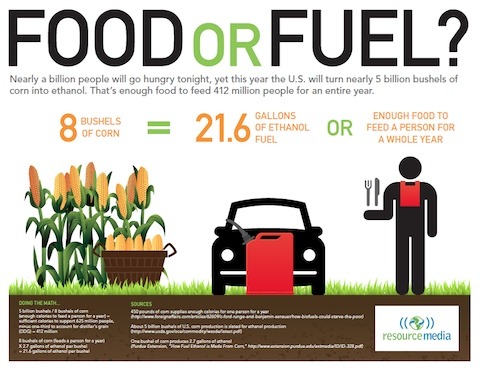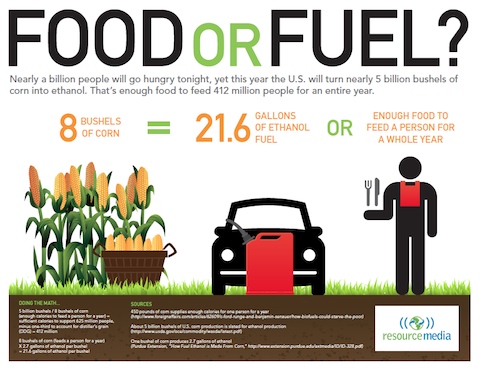How Many People Could Live For A Year On Corn Used For Biofuels?
"Biofuel" has long been an environmental buzzword, but what does it have to do with food? And how much does the average person really know about it?
Resource Media thinks that most people don't know the whole story behind biofuels, and today they're releasing an infographic to explain exactly how biofuels (specifically ethanol) relate to food.
The graphic is being released on the same day that the U.S. Department of Agriculture releases official crop estimates, a comprehensive forecast of supply and demand for major U.S. and global crops and U.S. livestock. But this graphic will be illustrating a radically different picture of the global food market: it shows how many people could live for an entire year solely on corn used for ethanol production in America.
Just how many people is that? 412 million people. Despite drought conditions in the Corn Belt, 40 per cent of U.S. corn is projected to be used to make fuel. That's food that could go to better use, advocates say — such as fighting hunger.
The info in the graphic comes as part of an emerging opposition to the expansion of ethanol production. The argument is that increasing ethanol production diverts billions of bushels of American corn away from food production every year, ultimately leading to skyrocketing prices on the global food market, and food shortages.
Particularly in developing nations such as those in Sub-Saharan Africa and India, they argue, a decreased food supply is expected to come as a result of overly ambitious biofuel production targets.
In India, for example, biofuel mandates are too high for their biofuel feedstock production. Feedstock must then be imported, and farmers may convert food cropland into biofuel feedstock — lowering food supply and raising food prices, says Govinda R. Timilsina, a senior economist with the World Bank and the lead author of a study on biofuel-driven food shortages in the May issue of Agricultural Economics.
Earlier this month, the UN reported that 26 countries, mainly in Sub-Saharan Africa, are still at extreme risk of hunger, with biofuels playing a key role in exacerbating the problem.
Despite the opposition, it's still extremely politically difficult to decrease biofuel production. In 2011 alone, U.S. ethanol production consumed 15 percent of the world's corn supply — up from 10 percent in 2008. This level will only rise, as the industry faces a mandate to boost minimum production by an additional 20 percent by 2015. The use of U.S. corn and soybeans as fuel is fully ingrained in public policy.
Still, the community is optimistic: studies imply that food prices should come down if biofuel growth is limited and future biofuel developments focus on non-food fuel sources such as garbage and crop residues.
To learn more about the issue, check out www.actionaid.org. For a better look at the graphic, click here.

